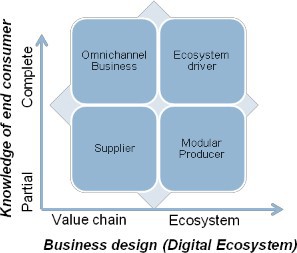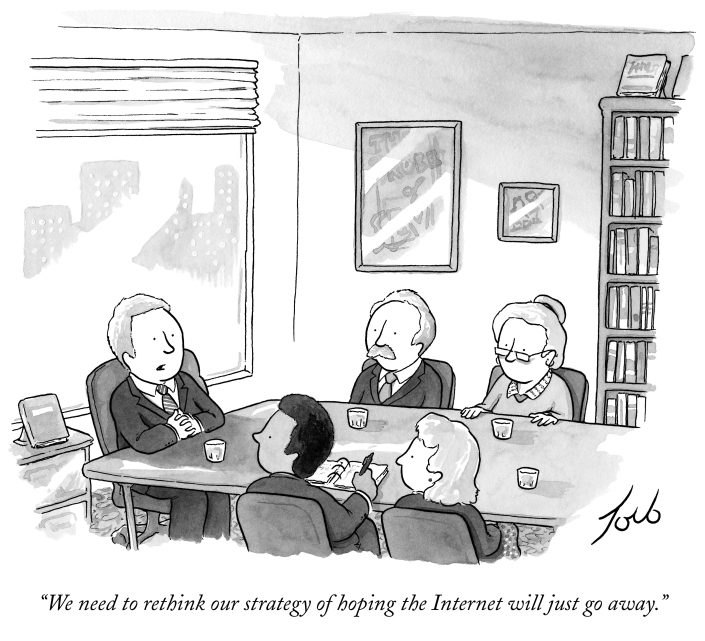Five (5) steps to formulate Digital Business Strategy
Five (5) steps to formulate Digital Business Strategy
- Establish Digital Business Strategy – How to determine where you want to play, how to provide differentiated value, and how to win (apart from Setting up Vision, Mission and Goals)
- Agree on the new Digital Business Model
- Assess current Digital Business Model against the new Digital Strategy and its impact on the ‘Core’
- Revitalize the ‘Core’ to improve Competitive Position
- Develop a roadmap to achieve the Digital Business Strategy
In the digital economy, corporations are witnessing threats that they have never perceived before. At the same time, digitization has brought in opportunities that are waiting to be seized. Irrespective of where your company resides in the digital space, the business leaders need to re-think their strategy and strategically invest in the future. Hence, the business leaders need to come up with a strategy that embraces digital technology and provide a platform for the organization to thrive in the future. This requires building a robust Digital Business Strategy (DBS) in which the business leaders need to think out of the box.
The basic steps involved to formulate the Digital Business Strategy are still founded on sound financial and business principles. However, the approach needs to be adapted to make sure business leaders are leveraging digital technologies , capabilities, and emerging digital business models to create and capture value effectively. Listed below are five (5) steps to developing the Digital Business Strategy.
1. Establish Digital Business Strategy
- Setup Vision, Mission and Goals
- Identify where you want to play, how to provide differentiated value, and how to win
Setting up the Vision, Mission and Goals is the first step towards establishing business strategy. Of course, the final goal of the corporation is to maximize long term growth and short term profitability.
However, the key elements to establishing a robust business strategy require business leaders to answer the following questions :
- Where do you want to play? This requires identification of which markets (i.e. customers) to target (also known as the Target Market)
- How do you provide differentiated value to the targeted customers? This requires assessment of the competitive landscape to ascertain the value being provided to the customers in that market, and how best to provide differentiated value (also known as Value Creation)
- How do you win in the targeted market? This requires assessment of internal capabilities that you currently have (or can quickly develop) to deliver differentiated value in a profitable manner (also known as Value Capture)
If the leadership team is able to recognize customer’s ‘active’ problems and assess the competitive landscape, it could come up with opportunities that are limited by the extent of its imagination. For example, a grocery store chain ‘Safeway’ unleashed a digital business ‘Digital pre-paid gift cards.’ Safeway spun this business off as a separate company ‘Blackhawk’ which is totally unrelated to its primary line of business (by the way, Blackhawk is the undisputed leader in this space). Another example is a white goods company that is making a foray into a services business by building a mobile application which will integrate all home based appliances across brands for the end consumer to control and manage remotely–an entirely different business model and a very imaginative new offering.
2. Agree on the new Digital Business Model
Once the target market (and end customer) has been identified and the Value Proposition has been quantified, the next step is to agree on the new Digital Business Model and understand the impact on the ‘Core’.
As per Peter Weil and Stephanie Woerner of MIT Research, executives have four options (see 2X2 matrix below) in selecting a business model,. The variables along the X and Y axis represents 1) Business design i.e. the extent to which executives like to control the Value Chain, or drive an ecosystem that delivers on the customer’s total needs 2) the extent to which they know about their end customer’s goals.
Based on these two variables, the matrix is divided into four quadrants, namely,
- Suppliers
- Omnichannel business
- Ecosystem drivers
Modular Producer

Business leaders can assess which quadrant they currently sit in and where would they like to be in the future. This is a soul searching opportunity which will define the future of their organization.
- Supplier : These companies have partial knowledge of the customers and operate as part of the value chain of another company. Examples are Applied Materials Inc. and KLA-Tencor
- Omnichannel Business: These businesses provide customers access to their products across multiple channels, including physical and digital channels. They have a complete understanding of customers’ needs and wants but limited to the products and services sold within the Value Chain. Examples are retailers such as USAA and Walmart
- Ecosystem Driver: Companies that develop an ecosystem by creating a relationship with other providers that offer complimentary (or competing) services. These companies are able to capture the buying behavior of the customer irrespective of whether they buy the company’s products or services. Hence, these companies have a complete understanding of customer needs and go beyond the traditional Value chain principles. Examples are Amazon, Apple, and Fidelity.
- Modular Producer model: These businesses provide plug-and-play products or services that can adapt to a variety of ecosystems. These companies have a limited view of the customer as they are limited to the data from the transaction that they process. Examples are PayPal and Apple Pay
Depending upon where you want to play, how you provide differentiated value, and how you want to win, one of the four business model options can be selected. In general, in the digital economy, the companies should strive to be in the Ecosystem driver space. In order to succeed and thrive in this space, the goal should be to be the business of ‘First choice,’ that is, a significant number of customers should come to your site first to buy (or search) products or services that they may be interested in.
3. Compare current Digital Business Model against the newly selected Digital Business model and understand its impact on the organization
Digital Business Models are not easy to change once implemented and have enormous ramifications as to how the organization shall operate in the future. One key area that needs to be understood is the impact on the ‘Core’ of the organization. The Core is something that allows you to deliver the benefits to your customer with much greater effectiveness than any other competitor. This secret sauce is something that makes it very difficult for your competitor to emulate you. If the newly selected Business Model requires you to develop new capabilities (i.e. secret sauce) that will deliver value to the customers and provide you the edge over your competitors, then it’s time to look internally and revitalize your ‘Core.’
4. Revitalize the ‘Core’ to improve Competitive Position
As mentioned above in Step #3, the Core is the secret sauce that cannot be replicated easily by your competitor. Some examples of Core are Network Effect, Customer Service, User Experience, and Low Cost. However, the Core is not the reason customers would buy from you; instead, they will look at the Competitive Position of your company. As per Bill Aulet, Managing Director of MIT’s Entrepreneurship program, the Core will help drive your ability to deliver certain benefits to the customer, which has to translate into value for the customer, which then leads to a better Competitive Position. The Core is how you are building a capability to differentiate yourself from your competitors, and it cannot be easily replicated by others.
Based on the selected Digital Business Model, the capability(s) that you need to develop may require you to revitalize the Core in order to provide you the Competitive Advantage. The revitalization of the Core and subsequent development of these Capabilities will most likely require leveraging Digital Technologies . The capabilities requiring digital technologies can be termed as ‘Digital Capabilities.’ Examples include an excellent website design that enhances User experience (UX) and an electronic platform that enables network effect. Please note that the value proposition in a digital ecosystem is not solely dependent on the Digital Capabilities. There are examples of Core that generate high value that are not enabled by digital technology such as providing unmatched Customer Service and being a Low Cost manufacturer.
5. Develop a roadmap to achieve the Digital Business Strategy
- Identify and develop Digital capabilities
- Digital External
- Definition – Product and services being offered by an organization that are digitally transferred and consumed by the end customer. For example, delivering ebooks, music downloads, financial policies, warranties, and airline tickets.
- Digital Internal
- Definition – Digital technologies utilized to develop an organization’s internal business capabilities. For example, supply chain visibility across the value chain (or ecosystem), collaboration, service catalogs, scorecards, and mobility.
- Digital External
- Organization readiness (culture, communication, employee involvement, talent and skills)
- Culture – Does your organization encourage employees to embrace digital technologies and capabilities? Is there an environment for innovation and experimentation? For example, Gary Loveman, the CEO of Caesar’s casino has transformed the casino from a second tier to number one gaming company in the world. ‘The employees are encouraged to run marketing experiments that help to develop and implement finely tuned strategies that add value and make sure customers keep coming back.’
- Communication – Is your organization ready for the digital change? Make sure that the digital strategy has been clearly communicated so that employees could serve as ambassadors for the organization and lead the change both internally and externally
- Talent and Skills – Does your organization have the right talent and skills to succeed and embrace the digital revolution? Do the leaders have the skills to understand the digital threats and opportunities? Are the leaders well prepared to formulate a strategy that will help their organization to thrive in the near future?
- Managing business complexity – Identify your operating ‘Sweet Spot’
In order to provide differentiated value to the customers, businesses add new products, services, and channels. This results in adding complexity to organization’s processes and systems. Enhancing value to the customer has a direct positive impact on the Revenue; however, at the same time complexity results in increasing an organization’s business processes costs (i.e. Operating costs). The organization has to make sure that it operates in a zone where the benefits of adding value to the customer outweighs the costs added due to complexity. This zone is also known as the ‘Sweet Spot.’
About the Author
Udey Chaudhry is an Executive Management Consultant, focusing on Digital Business Strategies and Execution, with extensive experience as a Strategy Consultant with top tier consulting firms and successful startups. He is an alumnus of MIT Sloan School of Management.
All opinions expressed by Udey Chaudhry are solely his own and do not reflect the view of any professional organization.
© 2015 Udey Chaudhry All Rights Reserved
REFERENCES:
Peter Weill and Stephanie L. Woerner, ‘Thriving in an Increasingly Digital Ecosystem’, MIT Sloan review, Summer 2015
Gerald C. Kane, Doug Palmer, Anh Nguyen Phillips and David Kiron, ‘Is Your Business Ready for Digital Future’, MIT Sloan review, Summer 2015
Bill Aulet, ‘Disciplined Entrepreneurship’, 2013 Edition
Erik Brynjolfsson, Professor, MIT Sloan School and MIT Center for Digital Business, ‘From Correlation to Causality’, March 31, 2013
Martin Mocker, Jeanne W. Ross, ‘Rethinking Business Complexity’, Center for Information Systems Research, February 2013
